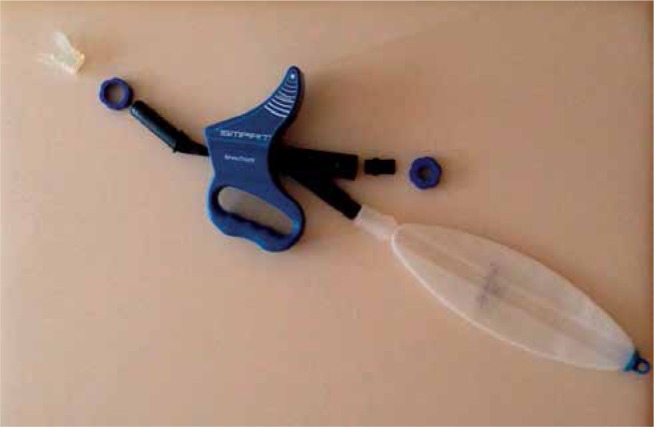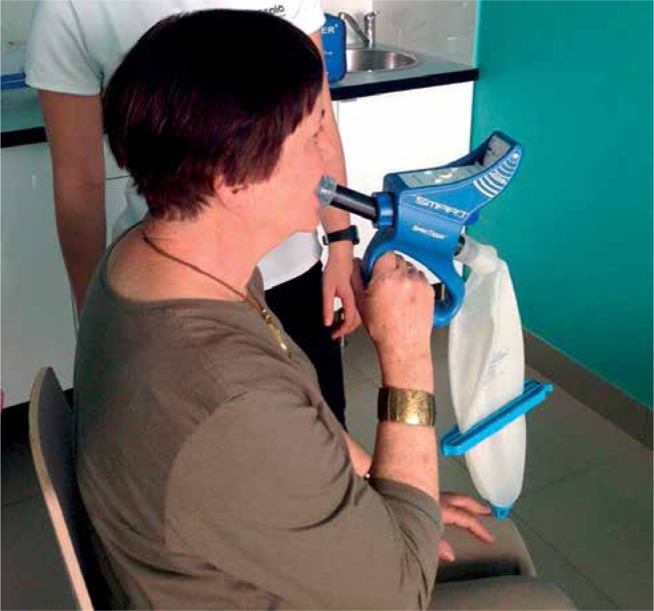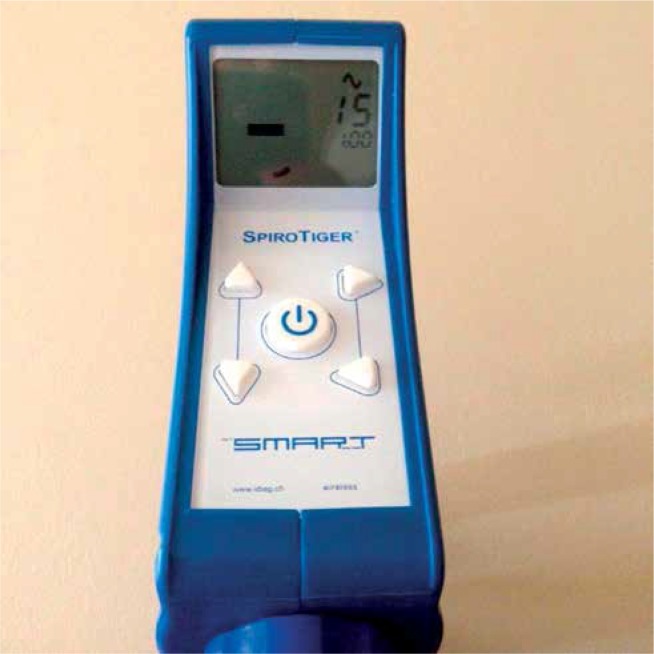Abstract
Introduction
There are studies demonstrating that respiratory muscles can be trained using proper stimulation. Positive effects have been achieved in patients with pulmonary diseases and in patients after thoracic surgery procedures using isocapnic hyperpnoea training with a SpiroTiger® device. The aim of this study was to investigate whether SpiroTiger® training has an impact on forced expiratory volume in one second (FEV1), exercise performance, respiratory muscle fitness, and health-related quality of life.
Material and methods
Search phrases “spirotiger” and “spiro tiger” were entered into the search engines of the following databases: Academic Search Complete, Medline, Ebscohost, and PubMed.
Results
One article about chronic obstructive pulmonary disease (COPD) and 4 articles about cystic fibrosis were found.
Conclusions
The positive effect of SpiroTiger® training on FEV1 cannot be unequivocally confirmed as it was found only in two of the five analysed studies. SpiroTiger® training has a positive impact on exercise performance measured with the six-minute walk test; it increases breathing muscle fitness in patients with COPD and in patients after thoracic surgery procedures, and it improves health-related quality of life.
Keywords: respiratory muscle training, lung function, SpiroTiger®
Abstract
Wstęp
Niektóre badania pokazują, że mięśnie oddechowe mogą być trenowane dzięki odpowiedniej stymulacji. Dającą pozytywne efekty metodą fizjoterapii w chorobach układu oddechowego oraz po zabiegach torakochirurgicznych jest trening isocapnic hyperpnea przeprowadzany z użyciem urządzenia SpiroTiger®. Celem pracy było sprawdzenie, czy trening SpiroTiger® ma wpływ na: natężoną objętość wydechową pierwszosekundową (forced expiratory volume in one second – FEV1), wydolność, wydolność mięśni oddechowych, jakość życia pacjentów.
Materiał i metody
Do baz danych Academic Search Complite, Medline, Ebscohost i PubMed zostały wpisane hasła: spirotiger oraz spiro tiger.
Wyniki
Znaleziono jeden artykuł na temat przewlekłej obturacyjnej choroby płuc (POChP) oraz 4 artykuły na temat mukowiscydozy.
Wnioski
Nie można stwierdzić, czy trening SpiroTiger® poprawia FEV1, ponieważ taką zależność wykazano jedynie w 2 z 5 artykułów. Trening SpiroTiger® wpływa korzystnie na poprawę wydolności ogólnej organizmu mierzonej za pomocą 6-minutowej próby marszowej. Poprawia też wydolność mięśni oddechowych osób cierpiących na POChP oraz po zabiegach torakochirurgicznych, wpływa pozytywnie na jakość życia pacjentów.
Introduction
Patients with chronic diseases of the respiratory system struggle with various ailments restricting their everyday functioning. One of the more significant restrictions in the course of chronic obstructive pulmonary disease (COPD) is dyspnoea. Hyperinflation of the lungs, increased dead space, and increased energy consumption during breathing lead to a reduction of the breathing reserve and post-exercise dyspnoea [1, 2].
Chronic lung disease leads to hyperinflation as well as to changes in the structure of the chest and the functioning of muscles [3]. In the case of cystic fibrosis [CF], lean body mass is reduced, which is associated with muscle mass reduction. This impairs the function of inspiratory muscles [4–6]. Due to the chronic character of these diseases, constant rehabilitation is required. It has been proven that physiotherapy aimed at improving chest parameters also improves lung function [7]. Some studies have demonstrated that respiratory muscles can be trained with appropriate stimulation, which has a positive effect on both exercise capacity [8, 9] and dyspnoea attacks [9, 10]. One physiotherapeutic method that helps achieve positive effects in respiratory diseases is isocapnic hyperpnoea training; it enables increased lung aeration and intensifies the action of respiratory muscles without leading to hypocapnia. Few studies on this type of training were conducted in the past due to the small availability of appropriate equipment [8, 11, 12]. Currently, isocapnic hyperpnoea conditions are achieved with a hand-held device called a SpiroTiger®, which has significantly increased the number of relevant studies. The described therapeutic method can be beneficial in various diseases of the respiratory system, including CF, COPD, and asthma; it can also help restore physical fitness after chest surgery procedures.
The aim of this article was to assess whether SpiroTiger® training improves:
respiratory parameters, particularly forced expiratory volume in one second (FEV1),
general fitness,
respiratory muscle fitness,
quality of life.
Material and methods
The search phrases “spirotiger” and “spiro tiger” were entered into the search engines of the following databases: Academic Search Complete, Medline, Ebscohost, and PubMed. Articles concerning respiratory system diseases were selected from the obtained publications. One article concerning chronic obstructive pulmonary disease (Fig. 1–3) [13] and four articles regarding cystic fibrosis [14–17] were found. No articles on other respiratory system diseases were found.
Fig. 1.
SpiroTiger® – mechanism of action
Fig. 3.
Training
Fig. 2.
Display
In all the analysed articles, respiratory muscle training was performed with the use of SpiroTiger® equipment, which was designed by a team of Swiss scientists [13]. The device consists of tubing connecting a silicon breathing bag with a mouthpiece at an angle of 90°. In the middle of this system is a sideport containing an opening that allows inspiration from and expiration to fresh air. The sideport also contains a piston valve. During training, the patient holds the device by the handle, which contains monitoring electronics and a small display [13]. When the patient draws breath through the mouthpiece, the breathing bag fills with expired air, characterised by higher concentrations of carbon dioxide. When the bag is filled, the valve opens and allows the remaining expired air to be expelled into the environment. The valve closes when expiration ends and inspiration begins. During inspiration, the breathing bag is first emptied completely, and then the sideport valve opens providing fresh air from the environment. The device provides the patient with auditory and visual feedback [14].
The specific parameters of the device allow for personalised respiratory training through maximal inspirations and expirations without risk of hyperventilation, unrestricted by limitations associated with lower limb fitness [14]. As a result, all respiratory muscle groups, both primary and accessory, are activated to the highest degree, improving chest flexibility and breathing coordination. While increasing the strength and flexibility of respiratory muscles, the training's effect is even more pronounced on muscle endurance.
Studied parameters
In all the analysed articles, the authors measured FEV1 both before and after the training [13–17]. PImax and PEmax were monitored by two research teams [13, 16]. Forced expiratory volume was measured in three cases [13–15]. Two research teams employed a six-minute walk test [13, 15]. The Swiss researchers also measured parameters including PEF, 12-sMVV, and VO2max; the methodology also included an exercise test on a treadmill [13]. In turn, the Italian research team measured FEF 25-75 and monitored the need for antibiotics during the experiment. Researchers measured MIP and MEP [15] as well as MEF50% and VC; the amount of expectorated sputum was also monitored [17]. Almost all researchers decided to employ questionnaires regarding the state of the disease [13, 16] or health-related quality of life [13–15]. In order to assess the state of the disease, Mahler's Baseline Dyspnoea Index was used before and Mahler's Transition Dyspnoea Index [13] was used after examinations assessing dyspnoea in patients with COPD; the Schwachmann Score [16] was used to assess the advancement of cystic fibrosis. Health-related QoL was measured with the SF-12 [13] and CFQ-R [15] questionnaires. In turn, Sartori et al. employed a questionnaire in which the patients evaluated their own physical fitness and adaptation to the training; the patients were asked to choose three activities they enjoyed that represented their fitness status and then grade them on a scale from 0 to 10 (worst to best) with consideration to difficulties associated with dyspnoea or other respiratory symptoms [14].
Duration of SpiroTiger® training
The duration of SpiroTiger® training ranged from four [17] and eight [13, 15] weeks to one year [14, 16]. The training intensity differed among the studies; the following regimens were used: twice per day for 10 minutes over a period of four weeks [17], twice per day for 15 minutes, five times per week during eight weeks [13], four times per week for 15 minutes during 8 weeks [15], and four times per week for 14 minutes during one year [14]. One study did not specify the number or duration of training sessions that were conducted over the period of one year [16].
In three of the studies, the SpiroTiger® training was combined with standard rehabilitation [14–17]. In two, the control groups underwent standard rehabilitation without any additional training [15, 17]. The control group in the study by Scherer et al. underwent placebo training sessions with a incentive spirometer; the training duration was the same as in the study group [13]. In the study by Sartori et al. each patient was their own control group because the results from the study year were compared with the results from the previous year; additionally, the SpiroTiger® training formed an alternative to high-pressure positive expiratory pressure (HiPEP) mask therapy, and each patient could return to using the latter method at any time [14]. The study by Dionysopoulou et al. did not include a control group [16].
Results
Forced expiratory volume in one second improvement by 13% was observed after four weeks of training in CF patients [17], and an improvement by 5.4% was noted after one year of training [14]. In the remaining study groups, FEV1 was not significantly improved [13, 15, 16]. The Swiss and Greek research teams noted improvements in the PEmax parameter [13, 16]. PImax improvement was observed in only one study [16]. The German researchers observed the improvement of MEF50% by 11% and VC by 8% in comparison to the study group [17]. In the group of COPD patients, MVV was improved by 7% in the study group and by 5% in the control group; VO2max increased by 2.5 ml/kg/min in the study group and decreased by 0.3 ml/kg/min in the control group [13].
In the study analysing the amount of expectorated sputum in the case of CF, the average amount was 12.2 g in the study group and 16.1 g in the control group [17]. In a questionnaire comparing the effectiveness of the SpiroTiger® device and the HiPEP mask in draining the sputum, the SpiroTiger® device received an average of 9.3 points, while the HiPEP mask – 2.9 points (on a scale of 0-10, worst to best) [14].
The SpiroTiger® device also received much better scores regarding the reduction of post-exercise dyspnoea (9.3 vs. 0) and reduction of cough (8.4 vs. 0.7) [14]. In a population of COPD patients, reductions in the occurrence of dyspnoea were noted in both the study group and the control group, but the difference was not significant [13]. Substantial improvements in respiratory muscle endurance measured as sustained ventilation were observed [13, 15], including an increase of 258% [13].
Both teams using the six-minute walk test noted significant improvements in test results after introducing SpiroTiger® training [13, 15]. In the case of COPD patients, the treadmill exercise test results were not significantly different from the controls [13].
The study group patients perceived their physical fitness as better than before the experiments [13, 14, 16, 17]. In one study, the patients observed no influence of the training on their quality of life [15]. Improvements were noted in terms of the Schwachman Score [16] and the physical component of the SF-12 questionnaire [13]. The results of the mental component of SF-12 did not improve [13].
During one year of training, none of the CF patients decided to interrupt training or to return to using the HiPEP mask [14]. The same study evaluated the adaptation of patients to this type of therapy: 15 out of 24 patients demonstrated good tolerance of the SpiroTiger® training [14].
Discussion
Influence on respiratory parameters
The influence of SpiroTiger® training on FEV1 cannot be unequivocally evaluated at this time. Although two research teams observed improvements of this parameter [14, 17], the remaining studies found no relationship between the studied training method and FEV1 [13, 15, 16].
Influence on fitness
Improvements in general fitness were noted in both studies employing the six-minute walk test [13, 15], suggesting a general fitness improvement. The Swiss team also noted an improvement in VO2max results by 2.5 ml/kg/min [13]. Interestingly, the same team found no statistically significant change in fitness measured by a treadmill test.
Influence on respiratory muscle fitness
Scherer et al. observed very substantial improvements among COPD patients with regard to respiratory muscle fitness measured as sustained ventilation; it increased by 258% in comparison to pre-training values, which constitutes excellent progress [13]. It is, therefore, even more surprising that Giacomodonato et al. found no significant improvement of this parameter [15]. Both teams conducted their studies for eight weeks; therefore, the possibility that the duration of the training was too short can be excluded. One training load difference was that the Swiss researchers conducted two daily sessions five days per week, while the Italian team conducted one daily session every day of the week. Although the workload of the CF patients [15] was smaller, this does not seem to be important enough to cause the difference; the extent of improvement achieved by the Swiss group would suggest that CF patients should experience improvement of at least slight significance. Perhaps improvement was not observed among the CF patients due to the small size of the study group (n = 10). It is possible that the measurement of this important parameter was performed by different methods in the two studies. Finally, one should keep in mind that the comparison is between two different conditions of the respiratory system; therefore, there is a possibility that SpiroTiger® training, while positively influencing the fitness of respiratory muscles in COPD patients, has no influence on respiratory muscle fitness in CF patients. Due to the small sample size, more research should be conducted in order to unequivocally verify this hypothesis.
Influence on health-related quality of life
In most cases, the patients assessed their physical fitness as better than before the introduction of SpiroTiger® training [13, 14, 16, 17]; improvements were noted in terms of the Schwachman Score [16] and the physical component of the SF-12 questionnaire [13]. Only one of the analysed studies showed no influence of this type of training on quality of life [15]; moreover, no improvements were noted in the results of the mental component of the SF-12 questionnaire. Therefore, it can be surmised that the training has a positive influence on quality of life and is well tolerated by patients, as demonstrated by the fact that none of the CF patients decided to return to using the HiPEP mask or to discontinue training with the SpiroTiger® device.
Limitations
The most significant limitation of the present article is the small number of publications related to the subject and the insufficient size of the study groups in the cited publications. More research is required in order to precisely verify the effectiveness of this type of training in patients with respiratory system diseases and patients after thoracic surgery procedures.
Conclusions
It cannot be unequivocally stated whether SpiroTiger® training improves FEV1 because such a relationship was demonstrated in only two [14, 17] of the five analysed publications.
SpiroTiger® training has a positive influence on the improvement of general fitness measured with a six-minute walk test [13, 16] and on VO2max [13]. No such relationship, however, was found in terms of fitness measured on a treadmill [13].
SpiroTiger® training improves the fitness of respiratory muscles in COPD patients. Further studies are required to study the training's influence on this parameter in CF patients.
SpiroTiger® training is beneficial in terms of quality of life in patients suffering from respiratory system diseases [13, 14, 16, 17].
Biography

Disclosure
Authors report no conflict of interest.
References
- 1.Tobin MJ. Respiratory muscles in disease. Clin Chest Med. 1988;9:263–286. [PubMed] [Google Scholar]
- 2.Bauerle O, Chrusch CA, Younes M. Mechanisms by which COPD afects exercise tolerance. Am J Respir Crit Care Med. 1998;157:57–68. doi: 10.1164/ajrccm.157.1.9609126. [DOI] [PubMed] [Google Scholar]
- 3.Bellemare F, Jeanneret A. Sex differences in thoracic adaptation to pulmonary hyperinflation cystic fibrosis. Eur Respir J. 2007;29:98–107. doi: 10.1183/09031936.00045606. [DOI] [PubMed] [Google Scholar]
- 4.Enright S, Chatham K, Inoescu AA, Unnithan VB, Shale DJ. The influence of body composition on respiratory muscle, lung function and diaphragm thickness in adults with cystic fibrosis. J Cyst Fibros. 2007;6:384–390. doi: 10.1016/j.jcf.2007.02.006. [DOI] [PubMed] [Google Scholar]
- 5.Arora NS, Rochester DF. Respiratory muscle strength and maximal voluntary ventilation in undernourished patients. Am Rev Respir Dis. 1982;126:5–8. doi: 10.1164/arrd.1982.126.1.5. [DOI] [PubMed] [Google Scholar]
- 6.Ionescu AA, Chatham K, Davies CA, Nixon LS, Enright S, Shale DJ. Inspiratory muscle function and body composition in cystic fibrosis. Am J Respir Crit Care Med. 1998;158:1271–1276. doi: 10.1164/ajrccm.158.4.9710079. [DOI] [PubMed] [Google Scholar]
- 7.Enright S, Chatham K, Ionescu AA, Unnithan VB, Shale DJ. Inspiratory muscle training improves lung function and exercise capacity in adults with cistic fibrosis. Chest. 2004;126:405–411. doi: 10.1378/chest.126.2.405. [DOI] [PubMed] [Google Scholar]
- 8.Belman MJ, Mittman C. Ventilatory muscle training improves exercise capacity in chronic obscurative pulmonary disease patients. Am Rev Respir Dis. 1980;121:273–280. doi: 10.1164/arrd.1980.121.2.273. [DOI] [PubMed] [Google Scholar]
- 9.Lisboa C, Villafranca C, Leiva A, Cruz E, Pertuze J, Borzone G. Inspiratory muscle training in chronic airflow limitation: effect on exercise performance. Eur Respir J. 1997;10:537–542. [PubMed] [Google Scholar]
- 10.Harver A, Mahler DA, Daubenspeck A. Targeted inspiratory muscle training improves respiratory muscle function and reduces dyspnea in patients with chronic obscurative pulmonary disease. Ann Intern Med. 1989;111:117–124. doi: 10.7326/0003-4819-111-2-117. [DOI] [PubMed] [Google Scholar]
- 11.Keens TG, Krastins M, Wannamaker EM, Levison H, Crozier DN, Bryan AC. Ventilatory muscle endurance training in normal subjects and patients with cystic fibrosis. Am Rev Respir Dis. 1977;116:853–860. doi: 10.1164/arrd.1977.116.5.853. [DOI] [PubMed] [Google Scholar]
- 12.Levine S, Weiser P, Gillen J. Evaluation of a ventilatory muscle endurance training program in the rehabilitation of patients with chronic obscurative pulmonary disease. Am Rev Respir Dis. 1986;133:400–406. doi: 10.1164/arrd.1986.133.3.400. [DOI] [PubMed] [Google Scholar]
- 13.Scherer AT, Spengler CM, Owassapian D, Imhof E, Boutellier U. Respiratory muscle endurance training in chronic obstructive pulmonary disease, impact on exercise capacity, dyspnea and quality of life. Am J Respir Crit Care Med. 2000;162:1709–1714. doi: 10.1164/ajrccm.162.5.9912026. [DOI] [PubMed] [Google Scholar]
- 14.Sartori R, Barbi E, Poli F, Ronfani L, Marchetti F, Amaddeo A, Ventura A. Respiratory training with specific device in cystic fibrosis: a prospective study. J Cyst Fibros. 2008;7:313–319. doi: 10.1016/j.jcf.2007.12.003. [DOI] [PubMed] [Google Scholar]
- 15.Giacomodonato B, Graziano L, Curzi M, Perelli T, De Sanctis S, Varchetta M, Alatri F. A randomized controlled study. Rome, Italy: Sapienza University of Rome; Respiratory muscle training with normocapnic hyperpnea in patients with cystic fibrosis. Workshop 21. Cleaning the lungs. [Google Scholar]
- 16.Dionysopoulou V, Stefanatou E, Paerpati G, Armeniakou E, Karianou E, Delaveri K, Georgiadi A, Poulipou E. The effects of a multimodality treatment on respiratory muscles and clinical indices in adult patients with cystic fibrosis. J Cyst Fibros. 2005;4:59–73. [Google Scholar]
- 17.Pause M, Kamin WE. Improved pulmonary function and increased sputum expectoration in CF patients after additional training with SpiroTiger® compered to supervised conventional physiotherapy alone. Germany: Pediatrics Pneumology, University of Mainz; 2006. Thematic Poster Session: From genes to outcome: a long distance. [Google Scholar]





